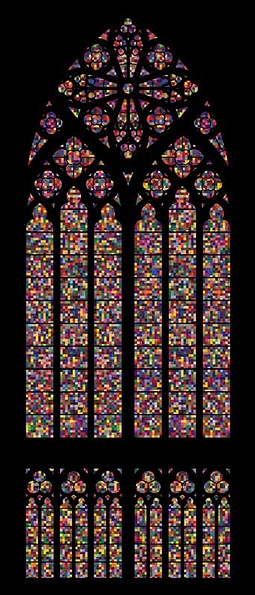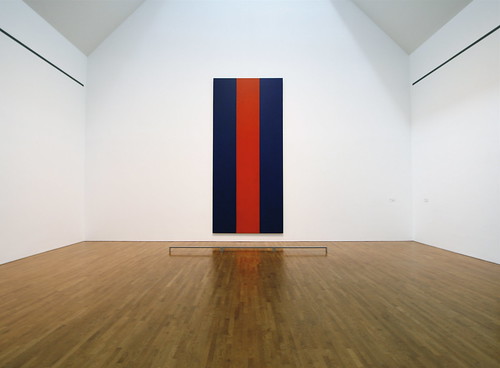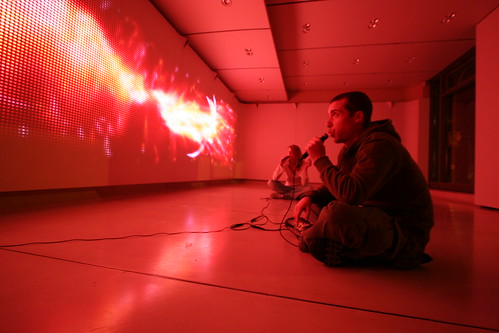Go West, Young Artist
But don't stop on Queen Street. The scene to check out these days is happening in Hamilton
BRUCE FARLEY MOWAT
Special to The Globe and Mail
HAMILTON, ONT. -- On a Friday night, Hamilton's old inner-city neighbourhood of Jamesville is overflowing with art lovers: Over at the Print Studio, a middle-aged woman from Etobicoke is inquiring about its workshops after viewing an exhibit by local printmaker Emily Brown. Down the street at the Blue Angel Gallery, a group of twentysomethings sits in on an improv theatre performance. Across the street, near the corner of Cannon, a crowd of moms, dads and grads gather at the Loose Canon Gallery for a group exhibition of emerging artists in the McMasterUniversity art program. It's a scene that happens every six weeks or so, when the galleries of Jamesville synchronize their opening nights. When the night is over, 250 to 300 people will have passed through the doors of each gallery.
You might expect to see something like this in Toronto or Montreal. The fact that it's happening in Hamilton, though, may qualify as a small miracle. In the once-sleepy Jamesville district -- the area in and around James Street North from Wilson Street to an old railway station -- seven galleries have sprung up over the past two years, with more expected to open soon. Out-of-town artists have begun making inquiries. Some Toronto artists, such as Robert Carley and Andrew McPhail, have already relocated to the SteelCity.
"I think this is a sign that Hamilton may very well be -- finally -- culturally maturing," says David Liss, a Hamilton expatriate and the curator of Toronto's Museum of Contemporary Canadian Art. "What's exciting about it is this thing sprung up organically. It didn't start at a boardroom. It has the ring of authenticity."
It's a textbook example of how the arts can revitalize an anemic neighbourhood, but it didn't happen overnight. Most of the SteelCity's current high-profile artistic alumni -- including Mr. Liss and artist Floria Sigismondi -- became known to the public after they left the confines of their hometown. Artists who choose to remain in the area are, understandably, a tenacious lot, forced by necessity to rely on self-built support mechanisms.
Hamilton Artists Inc., as one of the first artist-run co-operatives in Canada, initially opened its doors in the neighbourhood in 1975. In its 30-plus-year history, "The Inc." has moved around to several locations, but always remained in the neighbourhood.
"Artists have traditionally always established themselves in low-rent areas," the co-operative's current program director, Steve Mazza, says by way of explanation. "But we're not trying to compete with anyone, or align ourselves with whatever's currently in vogue."
The growth of the current strip of galleries really began with the May, 2003, opening of the You Me Gallery, which specializes in work by Hamilton area and Japanese-Canadian artists. The gallery is curated by one of the original members of the Inc., Bryce Kanbara.
"I began this gallery project as a way to express my disenchantment with the public art system -- which mostly supports its own infrastructure [of] directors, curators, educators, fundraisers and a small number of select artists," says Mr. Kanbara, who graduated from McMasterUniversity in 1970.
But for most galleries on the strip, Jamesville has become the choice of locale for their new ventures for two main reasons: the cheap real estate and the combined presence of Mr. Kanbara and the Inc. Another factor that has spurred the growth of the parallel-gallery system in Hamilton was the establishment in 2004 of a gallery intern program as part of McMasterUniversity's fine arts program. The program has effectively hooked up the university art community with the downtown scene.
The area's collective energy shows no sign of letting up. Retail outlets, such as Mixed Media, an art supply store run by H Magazine editor Dave Devries-Kuruc, are popping up. The Hamilton Media Arts, an artist-run new media collective, opens its new gallery space, The Factory, next month. And unlike most major centres, this district is solidly anchored: The majority of gallery owners own the buildings they work in -- something unheard of in today's Toronto or Vancouver.
All of this activity looks very familiar and very encouraging to Mr. Liss, who has seen the Parkdale neighbourhood in Toronto begin a similar turnaround.
"In the States, you see this kind of thing happening in places like Pittsburgh or Seattle, because the major centres are getting too expensive for artists. I think the same thing is happening in Hamilton, and I'd like to see the city, for once, nurture it."
Opening soon
Superstition be damned: This Friday the 13th will feature a confluence of openings in Jamesville. The main space of Hamilton Artists Inc. (3 Colbourne St., http://www.hamiltonartistsinc.on.ca) presents Totem, an exhibition by emerging artist Cathy Cahill featuring a selection of her whimsical, towering faux-fur animal totem poles. Ingrid Mayrhofer, a curator at the McMaster Museum of Art, will be showing her work Rapunzel, an installation piece featuring two- and three-dimensional elements. Both exhibitions open at 8 p.m.
Half a block north, the You Me Gallery (330 James St. N., http://www.youmegallery.ca) is kicking off a new year of programming with "Pictures of me when I was younger" or, "Ok, they're lamps", Brian Kelly's rambling suite of illuminated, found-object sculpture. Mr. Kelly forages the world for parts, but lives in Dundas, Ont. The show opens at 7 p.m.
The usual terminus for local art crawls, The Blue Angel Gallery (243 James St. N., http://www.blueangelgallery.ca), is featuring its weekly Friday night combination of visual arts, music, performance, poetry and open stage.
-- Bruce Farley Mowat

Steeltown Revisited
By: Bert Archer
Toronto Life, September, 2008
How do you know when Toronto is too expensive to be hip? When artists move to Hamilton. Our high-priced real estate is fuelling a growing exodus down the QEW. And it’s an entirely different migration from moving to the burbs. Hamilton – with it’s downtown-centred 19th-century layout, industrial heritage and fiery smokestacks – is as urban as it gets. Though it’s uneasily close to Toronto, it is not a satellite; it has an orbit of its own.
Writer Sky Gilbert and his partner, artist and curator Ian Jarvis, moved in 2003. “We couldn’t afford a house in Toronto,” he says, “and we wanted a charming old Victorian in a downtown core.” He found his house, just off the now burgeoning gallery strip of James Street North, for $90,000. “Hamilton does not smell,” he says. “It’s a beautiful ex-steel town. It’s very much like Baltimore or Queens – the little diamond in the rough beside the money-coloured ice palaces of the big city.”
Andrew McPhail, a 47-year old Toronto artist and long-time anchor of the Toronto gallery scene, moved in 2005. “We sold our house in Riverdale and bought a three-bedroom 1894 home here for $150,000, slightly less than a third of our Toronto house’s selling price.” As a result of the windfall, both he and his boyfriend, a former social worker, have retired.
At least one big developer is betting on the Richard Florida revitalization-through-the-creative-class effect. Harry Stinson, the original force behind the Candy Factory, which kick-started Toronto’s loft conversion boom, was all but run out of town after his One-King West project fell apart. He’s in negotiations to buy Hamilton’s Royal Connaught Hotel (which has been vacant for the past four years) and turn it into a condo-shopping complex.
Jim Chambers, founder of what became Gallery TRW and one of the forces behind the birth of West Queen West as a gallery district, has bought and sold three homes since moving six years ago. “I feel like a kid in a candy store, “he says. His latest purchase was a five-bedroom, three-storey detached Georgian Revival home built in 1890, which he picked up in July for less than $100,000. “Quite aside from the price difference,” Chambers says, “when neighbourhoods like Queen West get too expensive, they lose the qualities that made artists want to live there in the first place.”
For Hamilton, rampant gentrification is a way off. The city is still resolutely working class, and the James Street strip full of vacant storefronts, dollar stores and bars caters to what Chambers refers to as Hamilton’s broken people. Since the commute’s a bitch – and will remain so at least until the city gets its own VIA stop, plus expanded GO train service in 2010 – for the moment, Hamilton is for people who want to be Hamiltonians, and a bargain hunter’s paradise.
Links:
http://hubpages.com/hub/Creative-Class-Hamilton














